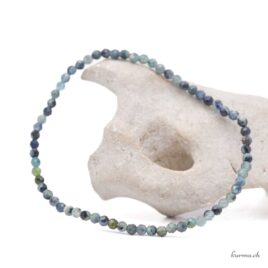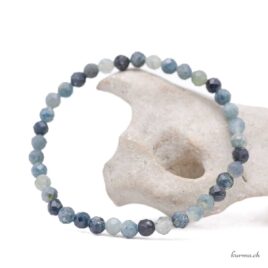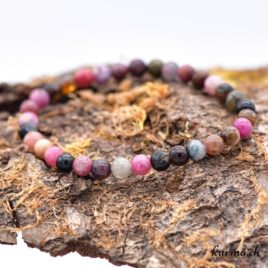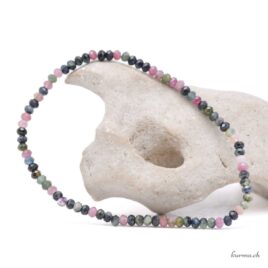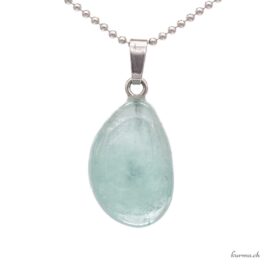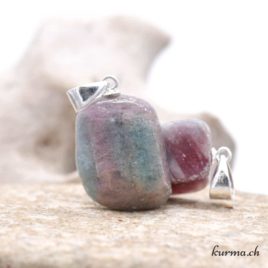Blue Tourmaline - Indigolite or Indicolite
gemstones in bracelets and pendants
Known as Indigolite or sometimes Indicolite, blue tourmaline and a rare mineral much sought-after in jewelry. Its color ranges
from light to dark blue, occasionally turquoise (Tourmaline de Paraiba), often with slight shades of green.
A fine, soothing and balancing stone in lithotherapy, it is also of great beauty.
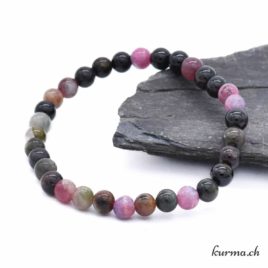
What are the virtues and properties of blue tourmaline in lithotherapy?
This generous stone, a symbol of love and connection to the subtle worlds in lithotherapy, is also heir to a rich symbolic history.
Origins and symbols
Indigolite is sometimes called Indicolite, which comes from the Latin word indicum, meaning "indigo", in reference to its natural blue color.
In ancient Egypt, it was recognized as having protective properties that could be used to guard against negative energies.
In China, its meaning was related to wisdom and communication, and it was recognized as beneficial for improving verbal expression.
In the West, during the Middle Ages, blue tourmaline symbolized authority and wisdom; it was associated with prestigious royal artifacts such as the crown, the scepter or the globe surmounted by a cross and the hand of justice, the famous royal regalia. These symbolic objects, the precious treasures of royalty, were used at official events such as coronations and coronations.
Lithotherapy benefits
It helps to calm the mind and reduce stress. It enables a better connection to the subtle worlds and thus helps develop creativity and trust in intuition.
Blue Tourmaline is used to better understand the symbolic cause(s) of disorders or illnesses, in order to facilitate healing.
Blue Tourmaline is an ideal companion for people who tend to repress their emotions and deny (consciously or unconsciously) their wounds. By helping you to communicate honestly, this stone helps you to come to terms with past traumas and painful memories.
A stone of honesty and fidelity, it invites you to clearly express your feelings, ideas, passions or projects. It's a wonderful gift to offer as a token of love or friendship.
What are its physical benefits?
On a physical level, in lithotherapy it helps to regulate and balance fluids in the body, boosting the immune system and helping to relieve kidney or bladder disorders.
It also acts on the eyes, throat and ears; so, in the event of illness affecting the ENT sphere, its symbols can provide relief and work to improve sight and hearing.
It's an excellent stone for improving sleep: it dispels nightmares and contributes to restful sleep.
How to use blue tourmaline
Methods of use may vary according to individual needs and purposes.
However, it is common to use Indigolite during meditation: to support deep relaxation, hold the stone in your hand, or place it on your forehead.
Blue Tourmaline is effective for balancing the throat chakra and the third eye chakra. To help your intuitive abilities and communicate better, position the stone on these chakras during energy healing sessions.
Wearing an Indicolite necklace or bracelet, or keeping the stone in your pocket, protects you from negative energies.
As jewelry or by keeping it close to you, it can also help you communicate better in public and express yourself clearly.
Use with other crystals to amplify its beneficial effects in lithotherapy
- Aquamarine for expression and clarity
- Azurite to awaken psychic abilities during meditation
- Rock crystal can enhance the effects of blue tourmaline
- Blue Fluorite promotes concentration and clarity
- Labradorite strengthens intuition
- Lapis lazuli for wisdom and communication
- Sodalite to calm and reason the mind.
How to purify a blue tourmaline?
Reload and clean
Sun/Moon, earth, fumigation, running water, breath, intention, singing bowl, form waves, prayers...Associated astrological signs
Pisces, Sagittarius, AquariusChakras
5ᵉ and 6ᵉ chakras - Throat and 3ᵉ eyeElement
Water - for balance and purificationAir - for thinking and communication
Mineralogy of blue tourmaline
Blue Tourmaline, Indicolite or Indigolite, is a rare variety of Tourmaline, composed mainly of complex borosilicate. These crystals are prized for their gemmological properties and lithotherapy applications.
It forms mainly in granitic pegmatites, mineral-rich igneous rocks.
Its blue color with green tints is due to the presence of iron impurities ( Fe²⁺) in its crystalline structure.
Blue tourmaline is scratch-resistant thanks to its relative hardness (7 to 7.5 on the Mohs scale).
The main deposits are in Brazil, Afghanistan, Nigeria and Namibia.
Lithotherapy
Mineralogy
- Hardness :
- 7.0-8.0
- Moths scale:
- 7, 8
- Strunz classification :
- Silicate
- Crystalline system :
- Trigonal
- Line color :
- White
- Density :
- 3-3.2
- Cleavage :
- Null
- Fracture:
- Irregular
- Transparency :
- Transparent to translucent
- Refringence :
- 1,603 - 1,655
- Birefringence :
- -0,015 à -0,025
- Pleochroism :
- Fort
- Fluorescence :
- Null
- Colors :
- Light blue, blue, dark blue, green blue
*Please note! Some minerals may be toxic and must not be licked or ingested (as such or in the form of powder, elixir or stone water) or be in prolonged contact with the skin or mucous membranes.
*The information on the stones described here are general indications based on our research and experience, and are not exhaustive.
Reproduction in whole or in part of this content is prohibited. More info

